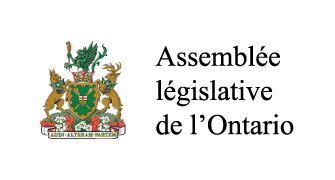Santé publique et épidémiologie : vue d’ensemble
Erica Simmons | Agent de recherche
Service de recherche
À la différence des médecins et du personnel infirmier qui veillent sur le bien-être de chaque patiente et patient, la santé publique et l’épidémiologie étendent leur action sur des collectivités et des populations entières. Armés de données épidémiologiques, les professionnelles et professionnels de la santé publique misent sur la réduction des blessures et des maladies chroniques ou autres qu’on peut prévenir. Parallèlement, les organismes de santé publique doivent réagir rapidement en cas d’éclosion de maladies contagieuses ou d’épidémie, voire en cas de pandémie d’une maladie nouvelle. Le présent rapport de recherche explique les fondements de la santé publique et de l’épidémiologie, et montre comment les enseignements tirés de l’histoire des pandémies orientent les pratiques sanitaires aujourd’hui.
L’éclosion de la COVID-19 qui a plongé la planète dans une pandémie au début de 2020 a aussi propulsé la santé publique et l’épidémiologie dans les grands médias. Les dirigeants de la santé publique, hier fort peu connus, furent soudainement braqués par les caméras dans les conférences de presse aux côtés des dirigeants politiques. Des termes comme « auto-isolement », « distanciation sociale » et « aplatir la courbe » font désormais partie de notre quotidien. Ainsi, la pandémie a placé la santé publique et ses concepts à l’avant-scène, mais il y a un travail de tous les jours en épidémiologie et en santé publique qui se poursuit en coulisse.À la différence des médecins et des infirmières qui veillent sur le bien-être de chaque patient, la santé publique étend son action sur des populations entières. Il peut s’agir d’une petite collectivité telle qu’une municipalité ou une région rurale, ou de l’ensemble d’une province, d’un territoire ou d’un pays. Les organismes internationaux comme l’Organisation mondiale de la Santé agissent à l’échelle mondiale. Mais quel que soit l’État qu’ils servent, les professionnels de la santé publique savent que dans un contexte mondialisé, « une maladie où que ce soit, c’est une maladie qui frappe partout[1] ». Même quand ils s’occupent d’une population locale, ils doivent garder l’œil sur ce qui se passe ailleurs, afin de pouvoir réagir rapidement en cas d’éclosion d’une maladie contagieuse comme la rougeole ou la grippe, voire en cas de pandémie d’une maladie nouvelle.
Figure 1: « Parler de vapotage avec votre adolescent : une fiche de conseils pour les parents »

Source : Santé Canada, « Considère les conséquences du vapotage »
« Considère les conséquences du vapotage » est une campagne de Santé Canada ciblant les jeunes.
Les pratiques de santé publique mettent l’accent sur les blessures et les maladies chroniques ou autres qu’on peut prévenir, comme le diabète et les maladies du cœur. Cette lutte passe par les facteurs de risque sociaux, économiques, environnementaux, démographiques et comportementaux qui pèsent sur une population donnée. Les campagnes antitabac, de vaccination et de promotion d’un mode de vie sain par l’alimentation et l’exercice régulier sont des initiatives de santé publique bien connues. Les organisations de santé publique s’occupent aussi des inspections de salubrité alimentaire, du contrôle de la qualité de l’eau potable, du suivi des niveaux de pollution de l’air et de bien d’autres choses encore.
Pour connaître les besoins de santé d’une population et y répondre, les professionnels de la santé publique font appel à l’épidémiologie. Cette science à la base de la santé publique consiste en la collecte, l’analyse et l’interprétation des données de santé concernant les populations, et en l’application de ces données dans la lutte contre les problèmes de santé[2].
Les épidémiologistes étudient la fréquence des incidents touchant la santé et les tendances que suivent ces incidents dans une population donnée. Par exemple, une éclosion de rougeole touchant plus d’individus que la normale au cours d’une année pourrait indiquer le début d’une épidémie. S’éclairant de données complexes, les épidémiologistes se penchent sur les causes et les autres facteurs inhérents aux incidents sanitaires tels que les maladies chroniques et les éclosions de maladies infectieuses.
Les données épidémiologiques nous indiquent notamment dans quelles collectivités ou populations la charge de morbidité est plus élevée qu’ailleurs pour des maladies chroniques comme l’asthme, le diabète et les maladies du cœur. Cela aide les professionnels de la santé publique à créer des programmes ciblant les populations les plus touchées par les maladies en cause. Parallèlement, les épidémiologistes font le suivi des éclosions de maladies infectieuses émergentes partout dans le monde, comme nous allons le voir plus loin.
Surveillance épidémiologique
Les épidémiologistes comme les professionnels de la santé publique ont besoin de données exhaustives provenant de la surveillance épidémiologique, que l’Organisation mondiale de la Santé définit comme suit : « la collecte, l’analyse et l’interprétation systématiques et continuelles de données sur la santé qui sont essentielles à la planification, à la mise en œuvre et à l’évaluation des pratiques de santé publique[3]. » Cette surveillance sert d’éclairage pour les politiques et les interventions en santé publique tout en générant les données nécessaires à l’évaluation de l’efficacité de ces interventions.
Les données de surveillance épidémiologique permettent aussi le repérage rapide des éclosions d’une maladie infectieuse et des autres urgences de santé publique. L’Agence de la santé publique du Canada travaille avec les réseaux provinciaux et territoriaux de surveillance épidémiologique pour recueillir une vaste gamme de données ayant trait à l’incidence des maladies chroniques, des anomalies congénitales, de la rougeole, de la grippe, du VIH/sida, de la maladie de Lyme et des vaccins ainsi qu’à la morbidité associée aux opioïdes, pour ne donner que ces exemples[4]. De la même façon, la surveillance en Ontario guide les professionnels de la santé publique de la province[5].
Déterminants de la santé
Les professionnels de la santé publique et les épidémiologistes ratissent large dans leur collecte et leur interprétation des données sur la santé. Leur but est de brosser un tableau des nombreux facteurs interreliés d’ordre social, environnemental et économique qui touchent la santé des individus d’une région ou d’une population donnée. Ces facteurs, appelés « déterminants de la santé », sont décrits approximativement comme « les conditions dans lesquelles les individus naissent, grandissent, vivent, travaillent et vieillissent[6] ». Ils englobent une myriade de facteurs comme « le revenu et le statut social, l’emploi et les conditions de travail, l’éducation et l’alphabétisation, les expériences de l’enfance, l’environnement physique, les mécanismes de soutien social et la capacité d’adaptation, les comportements liés à la santé, l’accès aux services de santé, les caractéristiques biologiques et le bagage génétique, le sexe, la culture ainsi que les éléments de race et de racisme[7]. »
La définition de ce qui constitue un déterminant de la santé – et donc un enjeu de santé publique – est en perpétuelle évolution. Les autorités de santé publique peuvent prendre la parole au sujet de toutes sortes d’enjeux sociaux qui d’après elles touchent la santé publique, comme les limites de vitesse en milieu urbain, les « déserts alimentaires » (c.-à-d., les endroits dépourvus d’accès local à des aliments frais et abordables) ou les problèmes d’insécurité alimentaire ou de logement sévissant dans certains endroits.
De plus, on s’entend de plus en plus pour dire, comme Santé Canada le fait observer, que « l’expérience de discrimination ou de racisme ou d’un traumatisme historique est un important déterminant social de la santé […][8] ». En effet, les preuves démontrent une prévalence accrue des maladies chroniques liées au stress chez les individus et les communautés subissant le racisme[9]. Devant ce constat, beaucoup d’organisations liées de près ou de loin à la santé publique, ainsi que des municipalités au Canada, aux États-Unis et ailleurs ont déclaré que le racisme systémique – en particulier celui contre les Noirs – est un problème de santé publique, voire une crise[10].
Au Canada comme aux États-Unis, la COVID-19 fait ressortir les inégalités en touchant plus durement les populations à faible revenu, racisées et marginalisées, chez qui on observe des taux supérieurs de contamination et de décès; un état de choses qui met ces enjeux en évidence[11]. Comme l’Alliance pour des communautés en santé de l’Ontario l’explique : « La COVID-19 n’amenuise pas ces disparités; elle les exacerbe[12]. »
Un autre élément important du mandat des autorités de santé publique consiste à planifier les interventions visant à contrer toute éclosion d’une maladie épidémique ou pandémique (« épidémie » se dit d’une éclosion régionale d’une maladie infectieuse présentant un nombre de cas inhabituellement élevé; une « pandémie » est une épidémie qui se répand dans le monde entier).
Les deux décennies ayant précédé la pandémie de COVID-19 ont été marquées par les épidémies d’Ebola, de SRAS, de Zika, de grippe porcine et de grippe aviaire, sans oublier la pandémie de grippe A (H1N1) ayant sévi en 2009-2010. Les spécialistes de la santé publique nous mettaient en garde depuis longtemps sur l’importance de se préparer à une pandémie qui serait inévitable, mondiale et dévastatrice[13]. Ainsi, l’Organisation mondiale de la Santé déclarait en 2011 que « le monde n’est pas prêt à affronter une grave pandémie de grippe ni aucune autre urgence sanitaire aussi menaçante, persistante et répandue autour du globe[14] ».
Mesures d’atténuation au sein des communautés
En contexte d’épidémie ou de pandémie lorsqu’il n’existe encore aucun vaccin ni traitement, les mesures sanitaires sont par nécessité axées sur plusieurs niveaux d’intervention. On parle alors de mesures non pharmaceutiques ou de mesures d’atténuation au sein des communautés. Ayant pour objet de freiner la progression de la maladie, elles comprennent notamment le lavage des mains systématique et d’autres mesures d’hygiène, le port du masque, la quarantaine, l’auto-isolement, la distanciation sociale, la recherche des contacts, la fermeture des écoles, commerces, lieux de divertissement et autres établissements où des rassemblements sont possibles, ainsi que l’interdiction des rassemblements de masse[15].
Cette stratégie de défense par niveaux a été décrite comme le « modèle du fromage suisse ». Le virologiste Ian Mackay explique que les « multiples couches protectrices, représentées par des tranches de fromage », ralentissent ou bloquent la propagation de la maladie infectieuse :
Aucune couche n’est parfaite; elles sont toutes trouées, et l’alignement de trous fait augmenter le risque de contagion. Mais la superposition de plusieurs couches – distanciation sociale, port du masque, lavage des mains, tests et recherche des contacts, ventilation et messages du gouvernement – atténue beaucoup le risque. La vaccination constitue une couche de défense supplémentaire[16].
Figure 2 : Modèle du fromage suisse contre une pandémie respiratoire
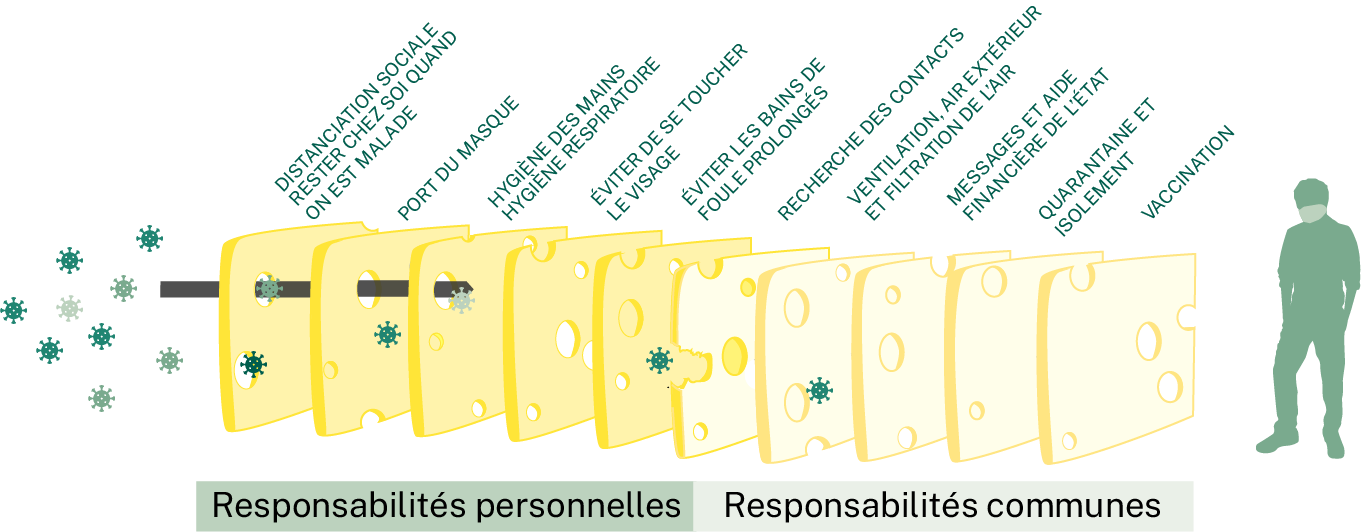
Source : The Swiss Cheese Respiratory Virus Defence, 2020, Ian M. Mackay (adaptation).
L’historien médical Howard Markel explique que les mesures d’atténuation au sein des communautés ont pour but d’aplatir la courbe épidémique :
Il s’agit de décaler la courbe épidémique vers la droite par une série de mesures non pharmaceutiques […] le but étant de retarder le pic épidémique et d’ainsi désengorger les hôpitaux, réduire la pression sur les services, faire diminuer le nombre de cas, atténuer les autres effets sur la santé, et gagner du temps dans le développement de nouveaux traitements[17].
Figure 3 : Aplatissement de la courbe
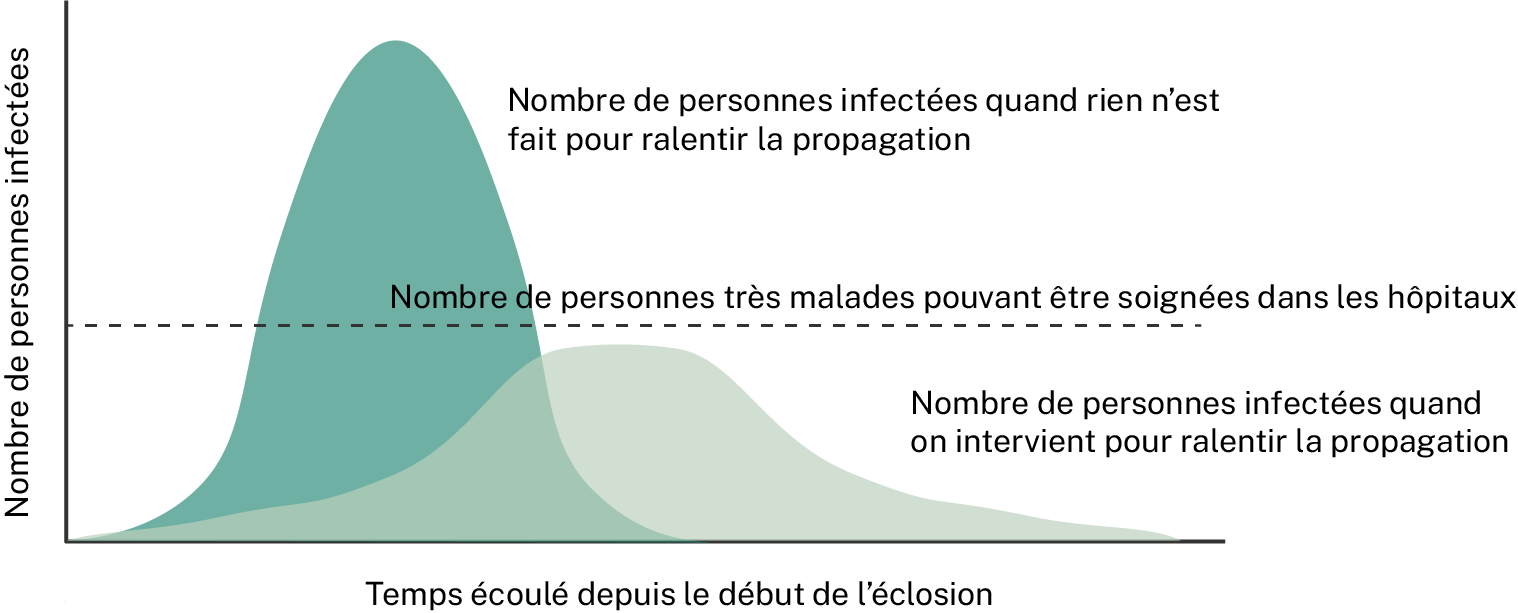
Source : Université du Michigan, Institut des politiques et de l’innovation en soins de santé, et Centres américains pour le contrôle et la prévention des maladies des É.-U. (adaptation).
Communications et confiance du public
Les mesures d’atténuation au sein des communautés étant difficiles à faire respecter, les autorités de santé publique doivent absolument communiquer efficacement afin de convaincre tout un chacun de modifier ses comportements pour protéger sa santé et celle des autres. En effet, la confiance du public est essentielle pour obtenir l’adhésion d’une société entière. Les Centres américains pour le contrôle et la prévention des maladies sont d’avis que les dirigeants de la santé publique ne seront « dignes de confiance et crédibles » aux yeux du public que s’ils se montrent « empathiques, bienveillants, honnêtes, transparents, dévoués, engagés, compétents et dotés de solides connaissances[18] ».
Pendant les six premiers mois de la pandémie de COVID‑19, les experts médicaux de partout ont eu du mal à comprendre les caractéristiques du virus, ses modes de transmission et ses effets sur la santé. Les connaissances scientifiques ont évolué, et il en alla donc de même des consignes sanitaires. Par exemple, au début de la pandémie, les autorités de santé publique au Canada comme aux États-Unis déconseillaient le port du masque[19]. Quelques mois plus tard, le masque était fortement recommandé, avant de devenir obligatoire peu après dans certains lieux fermés. Comme une chercheuse canadienne l’a constaté, « les autorités de santé publique nous ont demandé de modifier nos comportements en un éclair[20] ».
Pour les experts médicaux, cette incertitude scientifique (ou « épistémique ») en présence d’une nouvelle maladie est tout à fait normale. Toutefois, comme le reconnaissent les Académies nationales des sciences, de l’ingénierie et de la médecine des États-Unis, il y a un risque que le public « attribue cette incertitude à une défaillance de la science » et « il arrive que la communication des incertitudes affaiblisse l’autorité accordée aux scientifiques[21] ». Aux premiers mois de la pandémie, les autorités de santé publique autour du globe se sont évertuées à trouver de bonnes façons de communiquer l’incertitude scientifique au sujet de la COVID-19 sans affaiblir leur crédibilité.
Durant les premières éclosions de la COVID-19, certains pays comme la Corée du Sud, Taïwan et Singapour ont vu une forte adhésion de leur population aux mesures non pharmaceutiques. Au contraire, les États-Unis ont vu le public crier haut et fort contre ces mesures, surtout contre le port du masque[22]. Les chercheurs ont postulé que la « confiance sociale » au sein de la population était un facteur fondamental dans l’adhésion aux mesures non pharmaceutiques, cette confiance étant définie comme un alliage de la confiance dans les dirigeants politiques et du sens de responsabilité sociale envers les autres[23].
La recherche sur l’histoire des mesures anti-pandémiques est riche d’enseignements pour les actuelles mesures de santé publique contre les nouvelles pandémies telles que la COVID-19. En effet, chaque éclosion pandémique fait souffler un vent d’urgence sur les recherches au sujet des pandémies antérieures, les chercheurs étudiant les leçons du passé et leurs possibles applications actuelles.
La quarantaine : la plus vieille mesure sanitaire au monde
Figure 4 : Affiche de mise en quarantaine
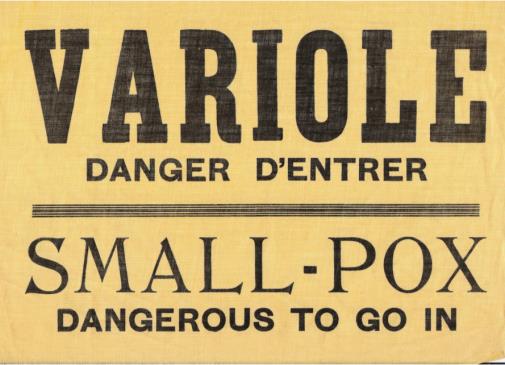
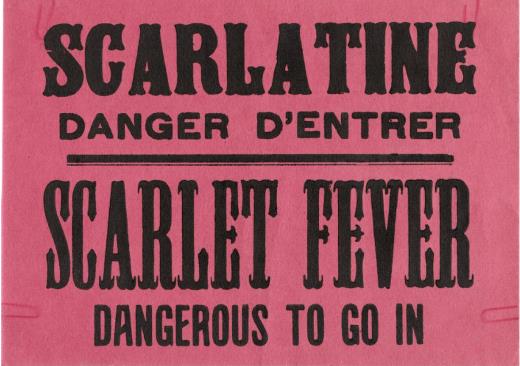
Crédit : Maison d’école du rang Cinq-Chicots, l’Association des amis du patrimoine
On placardait des affiches aux portes des maisons, des commerces, des écoles et à d’autres endroits pour garder les gens à l’intérieur et prévenir les autres de ne pas entrer.
De nombreuses mesures de base en santé publique telles que la quarantaine, le port du masque, la distanciation sociale, la recherche des contacts et l’hygiène des mains sont connues depuis plus d’un siècle. C’est particulièrement vrai pour la quarantaine – qui consiste à isoler les malades (ou les personnes potentiellement malades) des individus bien portants –, l’une des plus anciennes mesures sanitaires. Le terme lui-même a des origines qui remontent au milieu du XIVe siècle : quand la peste bubonique frappa Venise, on obligea les navires à rester à l’ancre pendant 40 jours (quaranta giorni) près d’une île de quarantaine afin de protéger les habitants de la ville contre la pandémie[24].
La mise en quarantaine des navires à leur arrivée au port – même en l’absence de cas connus d’une maladie à bord – s’est perpétuée comme pratique jusqu’au XXe siècle. On pouvait ordonner au navire de rester à l’ancre loin du rivage, ou obliger les passagers à rester sur une île de quarantaine ou dans un autre endroit prévu pour leur isolement avant de les autoriser à se mêler à la population locale. Qu’il véhicule des immigrants, des visiteurs ou simplement un équipage et des marchandises, tout navire était porteur d’un risque de contagion potentiellement dangereux[25].
La quarantaine et les autres mesures d’atténuation dans la communauté furent une arme essentielle contre les épidémies successives de choléra, mais aussi de variole, de diphtérie, de tuberculose et de bien d’autres maladies qui firent des ravages au Canada et aux États-Unis pendant les XVIIIe et XIXe siècles.
Par exemple, durant l’épidémie de variole qui sévit en Ontario en 1884, le tout jeune conseil de santé provincial réussit à contenir l’éclosion par l’application de ces mesures. Il interdit les rassemblements publics, fit fermer les écoles et les églises, fit suspendre le service de diligence desservant le secteur touché, et ordonna des quarantaines contrôlées par des agents sanitaires en poste le long des routes et aux gares de chemin de fer. Les demeures furent désinfectées et fumigées, et l’on recruta des étudiants en médecine qui vaccinèrent les gens en porte à porte[26].
Toutefois, ces mesures sanitaires n’étaient pas toujours bien accueillies. Dans la province voisine du Québec, les habitants des quartiers pauvres de Montréal les plus durement touchés par l’épidémie de variole « refusèrent de coopérer », rapporte l’historien Michael Bliss. On refusait d’aller en isolement dans les hôpitaux désignés et de se faire vacciner. « Quand la police sanitaire placardait des affiches sur leurs demeures, ils les déchiraient, et ils faisaient fi des mesures de quarantaine[27]. » Le taux de mortalité grimpa en flèche; des gens tombaient et mouraient en pleine rue[28].
Figure 5 : Bande dessinée antivaccination, Montréal, 1885
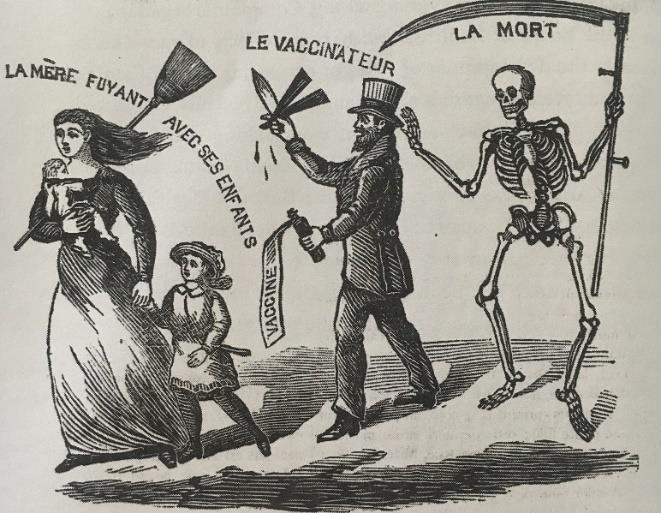
Source : La Bibliothèque de Livres Rares Thomas Fisher, Université de Toronto
Une mère fuyant avec ses enfants, avec un vaccinateur et la Mort à ses trousses.
Quand la Ville de Montréal rendit la vaccination obligatoire, des foules en colère se rassemblèrent et vandalisèrent les bureaux du conseil de santé. « La populace finit par assiéger l’hôtel de ville, raconte Bliss. Les protestations et les échauffourées avec la police dégénérèrent en violente émeute[29]. » Le maire fut obligé d’appeler la milice en renfort. Horrifiées par les bilans de mortalité hebdomadaires à Montréal et craignant la propagation, les autorités de l’Ontario et des États américains adjacents interdirent l’entrée aux Montréalais incapables de produire une preuve de vaccination en montrant des marques sur la peau ou une carte spéciale[30].
Grippe espagnole (1918-1919) : les « dangereux antimasques »
Arrivée dans le sillage de la Première Guerre mondiale, la pandémie de grippe espagnole, qui sévit en 1918 et 1919, traversa tout le Canada en un mois et fit dans le monde quelque 50 millions de victimes, voire plus[31]. Longtemps avant le développement de vaccins antigrippaux, le seul moyen de ralentir la progression de la maladie était le recours aux mesures non pharmaceutiques comme le port du masque, la distanciation sociale, la restriction des rassemblements de masse, ainsi que la fermeture des écoles, églises, commerces et établissements récréatifs comme les cinémas et les salles de quilles[32].
En Ontario comme ailleurs, les dirigeants de santé publique nageaient dans l’incertitude quant aux meilleures mesures à prendre. Craignant d’engendrer la panique, le conseil de santé provincial déconseilla de prime abord les mesures « risquant de trop perturber la vie économique et les activités quotidiennes ». Cependant, si des dirigeants locaux jugeaient nécessaire de fermer leurs écoles ou d’adopter d’autres mesures de cet ordre, les autorités provinciales n’interviendraient pas. Les journaux firent état de la progression de la grippe au Canada, aux États-Unis et en Europe, rapportant les bilans de mortalité, la surcharge des hôpitaux et du personnel médical, et la gamme de décisions des pouvoirs publics concernant les fermetures et d’autres mesures non pharmaceutiques[33].
Au début, il n’y avait pas de signe patent que la grippe espagnole se répandait comme une traînée de poudre. Le 2 octobre 1918, le Globe and Mail rapportait que la maladie « ne semblait pas se répandre de façon inquiétante à Toronto », aucun cas n’ayant été admis dans les hôpitaux de la ville. Le médecin-hygiéniste de Sudbury avait d’ailleurs dit qu’il n’y avait pas lieu de s’alarmer. Les médecins de l’endroit avaient fait état de quarante cas de grippe commune, « comme celle qu’on voit d’ordinaire », précisant qu’« il ne s’agissait pas de la grippe espagnole ». Or, moins d’une semaine plus tard, on sonnait l’alarme : la fameuse grippe avait « envahi » Toronto et Sudbury et s’étendait rapidement à Ottawa et à d’autres régions.
Les gros titres se firent sombres : « la mortalité en hausse »… « les hôpitaux sont à pleine capacité ». Le maire de Sudbury reçut un télégramme urgent de son homologue de Sherbrooke, au Québec, lui demandant s’il pouvait lui envoyer des infirmières. (Sudbury ne put se permettre que d’en envoyer une seule.) Le Toronto Daily Star rapporta que 10 000 élèves (le sixième de tous les élèves) de la ville s’étaient absentés de l’école « par crainte de contracter la maladie ». À Sudbury et à Toronto, les responsables de la santé publique avaient initialement décidé de laisser les écoles ouvertes, affirmant que les enfants étaient plus en sécurité en classe que dans la rue ou entassés au cinéma.
Figure 6 : « Portez le masque pour rester en vie! »
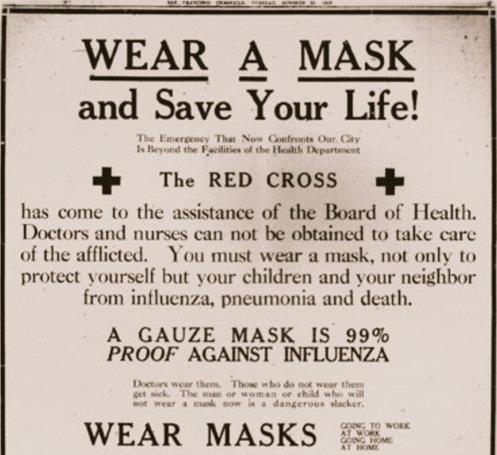
Source : Comité international de la Croix-Rouge (CICR)
En 1918, la Croix-Rouge clouait au pilori ceux qui refusaient de porter le masque, les qualifiant de « danger public ». (En 2020, le Comité international de la Croix-Rouge a republié en ligne cette affiche avec ce message : « Nous l’avons dit en 1918. Nous le répétons aujourd’hui. »)
Partout en Amérique du Nord, on se dépêcha d’intervenir, mais il n’y avait aucun consensus sur le comment. Le Globe rejeta l’idée du confinement, qu’il qualifiait de « mesure extrême » n’ayant produit « aucun effet mesurable » à Boston, au Massachusetts. Le médecin-hygiéniste de Sudbury se faisait rassurant devant le public, affirmant qu’il n’y avait pas lieu d’adopter des mesures « draconiennes ». Le confinement et les fermetures étaient « très pénalisants » et ne faisaient que paralyser l’économie.
Charles Hastings, le médecin-hygiéniste de Toronto, conseilla le magasinage par téléphone pour diminuer l’achalandage dans les commerces. Il fallait aussi éviter les foules – et les embrassades en public. À London, on adopta des « règles strictes » interdisant à quiconque souffrant d’une toux ou d’un rhume de quitter sa résidence ou d’« éternuer dans l’air libre ». On ferma écoles et cinémas à Lindsay, tandis qu’on rejeta ces mesures à Kingston et à St. Thomas. Le public fut mis en garde contre les remèdes de charlatan, et pressé d’éviter les tramways bondés.
À l’heure où la maladie se propageait pourtant de façon inquiétante des deux côtés de l’Atlantique, Hastings déplora le fait que trop de gens à Toronto persistaient à faire fi des consignes sanitaires. « Aucun ministère de la Santé ne peut tirer les gens par l’oreille et leur dire quoi faire. On ne peut pas les forcer à prendre les précautions nécessaires », se plaignit-il non sans frustration[34]. Le Globe accusa Hastings de blâmer la victime, rapportant ses commentaires sous la sarcastique rubrique « Si vous avez la grippe espagnole, c’est votre faute! »
Vers la mi-octobre, il était évident qu’il fallait agir avec force. Le 15 octobre, on ferma les écoles torontoises. Le lendemain, le médecin-hygiéniste de Kingston annonçait un confinement pour toute la ville, tandis qu’à Sudbury on interdisait les rassemblements publics en même temps qu’on fermait écoles, églises et lieux de divertissement. Les restaurants de Sudbury ne pouvaient plus accueillir que 25 clients à la fois en salle à manger et devaient retirer les chaises excédentaires. Toronto ferma ses cinémas et autres lieux de divertissement le 19 octobre. À la fin du mois, un homme de Sudbury fut arrêté pour avoir violé la quarantaine : il conduisait sur une voie publique dont les autorités sanitaires locales avaient ordonné la fermeture.
La pandémie sévissant par vagues, les villes et localités de la province ordonnèrent, levèrent, puis de nouveau ordonnèrent des mesures de confinement et de quarantaine.
Figure 7 : Le confinement au Québec, 1918
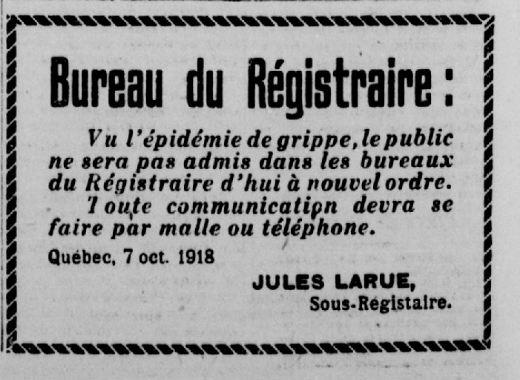
Crédit : L’Action catholique, 8 octobre 1918, Bibliothèque et Archives nationales du Québec
Figure 8 : Le confinement à Montréal, 1918
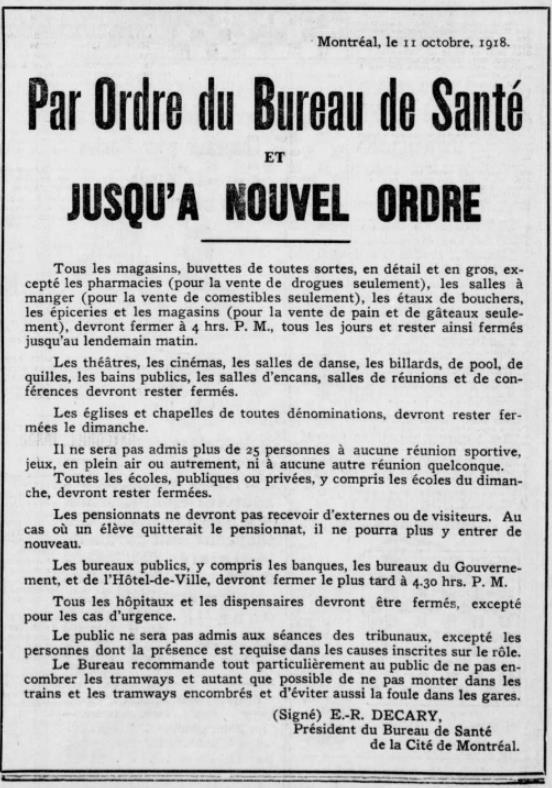
Crédit : La Presse, 12 octobre 1918, Bibliothèque et Archives nationales du Québec
Figure 9 : Cinéma fermé durant la pandémie de grippe espagnole, 1918
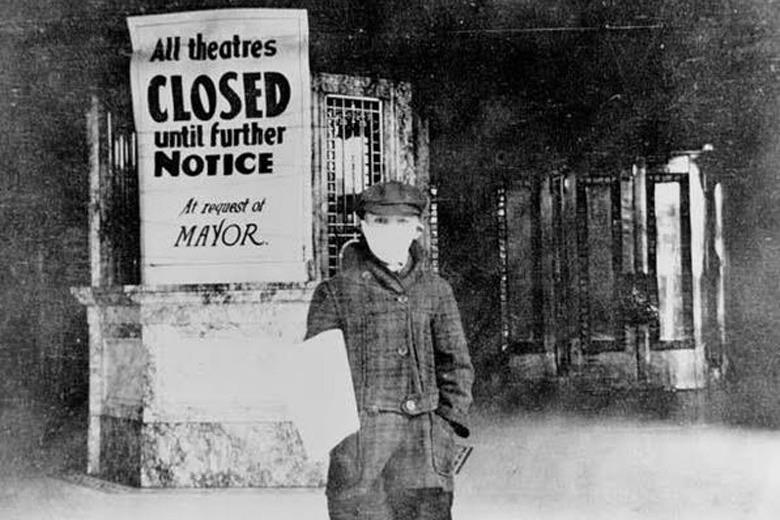
Source : Collection de la Société historique de Seattle, MOHAI, SHS6338B
Partout en Amérique du Nord, on ferma les cinémas et les autres lieux de rassemblement durant la pandémie de grippe espagnole.
En 2006, l’historien médical Howard Markel était membre d’une équipe de recherche qui évalua l’efficacité des mesures non pharmaceutiques adoptées dans les grandes villes américaines durant la pandémie de grippe espagnole. Cette équipe s’intéressa également aux interventions du gouvernement et des autorités sanitaires contre la résistance du public au port du masque et à d’autres mesures sanitaires[35].
Markel et ses coéquipiers apprirent que les villes ayant agi rapidement, soit avant que le virus ait eu le temps de se répandre dans l’ensemble de leur population, en appliquant de concert plusieurs mesures non pharmaceutiques sur une période prolongée « purent déplorer des bilans de morbidité et de mortalité beaucoup moins lourds que les villes plus lentes à agir[36] ». Autrement dit, ces villes ont réussi à aplatir la courbe.
Les résultats de cette étude, souligne Markel, ont guidé les Centres américains pour le contrôle et la prévention des maladies dans la rédaction de leur guide de planification d’interventions en cas de pandémie, paru en 2007, de même que dans la révision de ce guide en 2017. Ces documents ont eu une grande influence sur l’application des mesures anti-pandémiques autour du globe[37]. Faisant écho aux conclusions de l’équipe de recherche susmentionnée, ce guide fait valoir l’efficacité d’une stratégie communautaire privilégiant l’application rapide et ciblée de plusieurs couches de mesures non pharmaceutiques.
SRAS (2002-2003) : le principe de précaution
L’éclosion du SRAS (syndrome respiratoire aigu sévère) est parfois qualifiée de première pandémie du 21e siècle. C’est à Toronto que l’on vit la plus forte éclosion de SRAS en Amérique du Nord, et ce fut le seul endroit au monde frappé par deux vagues; la maladie y fit en tout 44 morts[38]. En 2006, une commission d’enquête conclut que la plus importante leçon à retenir du SRAS est le « principe de précaution » selon lequel « il faut prendre des mesures pour diminuer les risques sans attendre la certitude scientifique[39] ».
Depuis l’arrivée de la COVID-19, l’idée du principe de précaution est souvent reprise dans les débats sur la question de savoir s’il aurait fallu imposer le port du masque au public dès le début de la pandémie[40]. Au début, nous l’avons vu, les autorités sanitaires déconseillèrent le port du masque, affirmant qu’aucune preuve scientifique ne démontrait leur efficacité en dehors des milieux cliniques.
Cependant, un article du Journal canadien d’anesthésie explique que, même si les cliniciens appliquent habituellement les principes de la médecine fondée sur des données probantes, en contexte de pandémie « les preuves nécessaires […] sont limitées, non avérées et en constante évolution ». Les auteurs de l’article sont d’avis que « lors d’une crise sanitaire, les dirigeants n’ont pas le luxe d’attendre des preuves scientifiques sûres lorsqu’ils doivent agir. Il leur faut aborder le problème d’une autre façon face à l’incertitude afin de réduire les risques inhérents aux décisions à prendre[41]. »
Figure 10 : « Masque ou couvre-visage obligatoire »
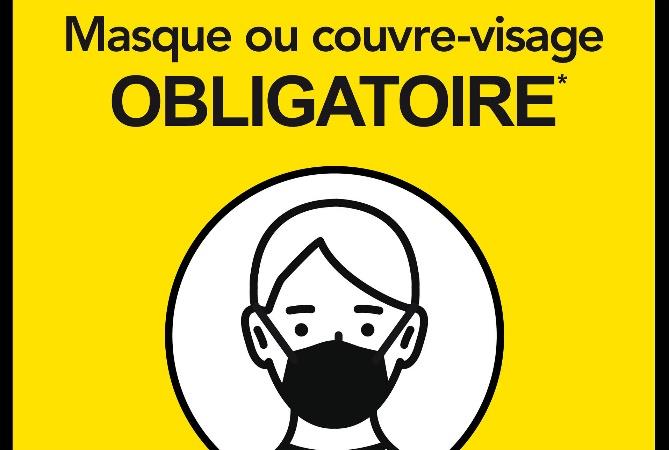
Source : Santé publique de Thunder Bay
Lassitude face à la pandémie
Les nombreuses similitudes entre la pandémie de COVID-19 et celles du passé sont frappantes. À l’instar de leurs homologues qui luttèrent contre la grippe espagnole il y a un siècle, les États et les autorités sanitaires des quatre coins du monde ont eu fort à faire pour décider des meilleures mesures à prendre. Faut-il rendre le port du masque obligatoire? Faut-il fermer les écoles, les restaurants et les autres commerces? Si oui, pendant combien de temps? Il était essentiel de trouver le moyen de communiquer aux gens le caractère urgent de la situation sans toutefois les paralyser par la peur ou le désespoir.
En revanche, on en sait aujourd’hui davantage sur les effets indésirables que le confinement, la distanciation sociale et les autres mesures peuvent avoir sur la santé mentale. Par exemple, l’Organisation mondiale de la Santé (OMS) a publié des recommandations pour aider les décideurs de la santé publique et les gouvernements à gérer la « fatigue pandémique », définie comme « la démotivation pour suivre les comportements de protection recommandés […] ». L’OMS recommande de « comprendre la population » et de « [m]ontrer que l’on comprend les difficultés rencontrées par les gens […] et tenter d’apporter des solutions[42] ».
Figure 11 : Recâlinons-nous!
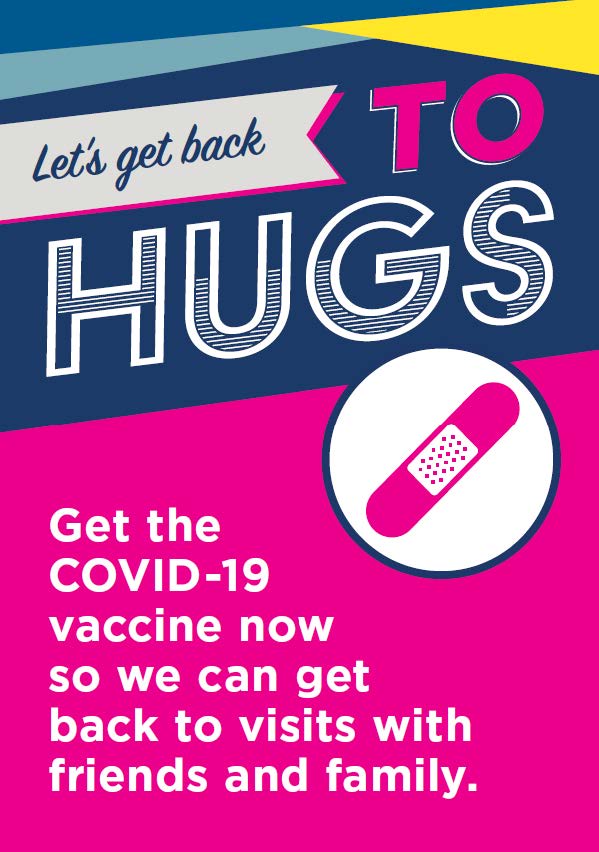
Source: Bureau de santé publique de Toronto, 2021
Une affiche du Bureau de santé publique de Toronto explique comment la vaccination permettra à tout le monde de reprendre une vie prépandémique normale, sans distanciation.
Au début de 2021, avec la disponibilité croissante d’un certain nombre de vaccins efficaces contre la COVID-19, les stratégies de santé publique ont été réorientées afin d’encourager toutes les personnes admissibles à se faire vacciner, dans le but de ralentir ou même d’arrêter la propagation de la maladie. De nombreuses administrations ont commencé à exiger une preuve (un certificat) de vaccination ou les résultats d’un test récent de dépistage de la COVID-19 à l’entrée des restaurants, des salles de sport, des théâtres et d’autres espaces fermés, tandis qu’un « passeport » vaccinal était requis pour franchir la frontière. Certaines organisations ont introduit la vaccination obligatoire : pour travailler, étudier ou s’adonner à d’autres activités, il fallait produire une preuve de vaccination ou de test récent de dépistage de la COVID-19.[43]
Comme de nombreuses autres mesures de santé publique utilisées pendant la pandémie de COVID-19, ces outils (vaccination obligatoire, certificats et passeports) sont employés au Canada et ailleurs depuis au moins un siècle pour prévenir la propagation de la variole, de la fièvre jaune, de la typhoïde, du choléra et d’autres maladies contagieuses dont on ne parle pratiquement plus aujourd’hui.
Dix-huit mois après le début de la pandémie, alors que les taux de vaccination augmentaient dans de nombreux pays et que les taux d’hospitalisation pour les formes graves de la COVID-19 diminuaient, certains se demandaient si la fin de la pandémie était à portée de main. Les spécialistes en santé publique et en épidémiologie s’entendaient plutôt pour dire qu’il était peu probable que la COVID-19 disparaisse complètement. Elles et ils prévoyaient plutôt qu’elle deviendrait endémique, c’est-à-dire qu’elle atteindrait des niveaux plus prévisibles et gérables, un peu comme la grippe saisonnière.[44]
Au cours de ce que beaucoup espéraient être ses derniers stades, comme c’est le cas depuis le début, la pandémie de COVID-19 a ouvert la porte à des occasions sans précédent de recherche, d’innovation et d’initiatives concertées en santé publique et en épidémiologie partout dans le monde. S’il est vrai que les leçons à retenir ne se préciseront qu’après coup, cette pandémie se traduira assurément par une redéfinition de la santé publique et de l’épidémiologie.
Notes
[1] David Quammen, « Why Weren’t We Ready for the Coronavirus? » New Yorker, 4 mai 2020.
[2] Richard C. Dicker, Principles of Epidemiology, 2e éd., département de la Santé et des Services sociaux des États-Unis, Service de santé publique, bureau du programme d’épidémiologie des Centres pour le contrôle des maladies, 1992, p. 2.
[3] Organisation mondiale de la santé (OMS), « Public Health Surveillance ».
[4] Agence de la santé publique du Canada, « Surveillance de la santé publique au Canada ».
[5] Ministère de la Santé et des Soins de longue durée, Protocole d’évaluation et de surveillance de la santé de la population, 2018.
[6] OMS, « Social Determinants of Health », 2020.
[7] Conseil canadien des déterminants sociaux de la santé, Agence de la santé publique du Canada, « Les principales inégalités en santé au Canada – Sommaire exécutif », 28 mai 2018.
[8] Santé Canada, « Déterminants sociaux de la santé et inégalités en santé », 25 juillet 2019.
[9] Association canadienne de santé publique, « Plaidoyer; Énoncé de positions; Racisme et santé publique », 17 décembre 2018.
[10] Nick Westoll, « Ontario health leaders call on province to declare anti-Black racism public health crisis », Global News, 3 juin 2020, et « Toronto board of health unanimously votes to recognize anti-Black racism as public health crisis », Global News, 8 juin 2020; Association américaine de la santé publique, « Declarations of Racism as a Public Health Issue ».
[11] John Paul Tasker, « More racially diverse areas reported much higher numbers of COVID-19 deaths: StatsCan », CBC News, 10 mars 2021.
[12] Alliance pour des communautés en santé, « Statement from Black Health Leaders on COVID-19’s impact on Black Communities in Ontario », communiqué, 2 avril 2020; Grace-Edward Galabuzi, « Systemic racism is at the heart of economic inequality – and of how we get sick and die », TVO, 24 février 2021.
[13] Philip Hunter, « Inevitable or avoidable? Despite the lessons of history, the world is not yet ready to face the next great plague », EMBO (European Molecular Biology Organization) Reports vol. 8, no 6, 2007.
[14] OMS, bureau régional de l’Europe, « Pandemic Preparedness ».
[15] J. Xiao, E. Shiu, H. Gao et coll., « Nonpharmaceutical Measures for Pandemic Influenza in Nonhealthcare Settings – Personal Protective and Environmental Measures », Emerging Infectious Diseases, vol. 26, no 5, 2020; OMS, Non-pharmaceutical public health measures for mitigating the risk and impact of epidemic and pandemic influenza, 2019.
[16] Siobhan Roberts, « The Swiss Cheese Model of Pandemic Defense », New York Times, 7 décembre 2020.
[17] Howard Markel, « What history revealed about cities that socially distanced during a pandemic », PBS News Hour, 20 avril 2020.
[18] Abbigail J. Tumpey, David Daigle et Glen Nowak, « Communicating During an Outbreak or Public Health Investigation », Centres américains pour le contrôle et la prévention des maladies, Service de renseignements épidémiologiques, 2018; Déclaration commune des commissaires fédéral, provinciaux et territoriaux à la protection de la vie privée, « Appuyer la santé publique et bâtir la confiance des Canadiens : principes de protection de la vie privée et des renseignements personnels pour les applications de traçage des contacts et autres applications similaires », Commissaire à l’information et à la protection de la vie privée de l’Ontario, 7 mai 2020; Anne Marthe van der Bles et coll., « The effects of communicating uncertainty on public trust in facts and numbers », actes de l’Académie des sciences des États-Unis, 7 avril 2020.
[19] Megan Molteni et Adam Rogers, « How Masks Went From Don’t-Wear to Must-Have », Wired, 2 juillet 2020.
[20] Wendy Glauser, « L’efficacité des messages de santé publique pendant la pandémie étudiée », Affaires universitaires, 2 septembre 2020.
[21] A.M. van der Bles, S. van der Linden, A.L.J. Freeman et coll., « The effects of communicating uncertainty on public trust in facts and numbers », actes de l’Académie des sciences des États-Unis, 7 avril 2020.
[22] Ritu Prasad, « Coronavirus: Why is there a US backlash to masks? », BBC News, 5 mai 2020.
[23] Gideon Lewis-Kraus, « Trust Fails: Why Have Some Asian Countries Controlled their Outbreaks so Well? », Wired, juillet/août 2020.
[24] Howard Markel, « Science of Social Distancing », webinaire : COVID-19 Conversations, Association américaine de la santé publique, 2020; E. Tognotti, « Lessons from the History of Quarantine, from Plague to Influenza A », Emerging Infectious Diseases, vol. 19, no 2, 2013.
[25] Christopher Rutty et Sue C. Sullivan, La santé publique : Une histoire canadienne, Association canadienne de santé publique, 2010, p. 7ff.
[26] Michael Bliss, The Making of Modern Medicine: Turning Points in the Treatment of Disease, Presses de l’Université de Toronto, 2011, p. 21; Rutty et Sullivan, p. 1.10-11.
[27] Bliss, p. 15.
[28] Bliss, p. 15-18.
[29] Bliss, p. 18.
[30] Bliss, p. 18-20.
[31] D. Ann Herring, éd., Anatomy of a Pandemic: The 1918 Influenza in Hamilton, Allegra Print and Imaging, 2006.
[32] Markel, « What history revealed… », 20 avril 2020.
[33] Toronto Daily Star et Globe and Mail, 1er octobre au 31 décembre 1918.
[34] « If You Have ‘the Flu’ It’s Your Own Fault », Globe and Mail, 10 octobre 1918.
[35] H. Markel, AM Stern, JA Navarro et coll., « Nonpharmaceutical Influenza Mitigation Strategies, US Communities, 1918–1920 Pandemic », Emerging Infectious Diseases, vol. 12, no 12, 2006.
[36] Markel, Stern, Navarro et coll., 2006.
[37] Centres américains pour le contrôle et la prévention des maladies, Interim Pre-pandemic Planning Guidance: Community Strategy for Pandemic Influenza Mitigation in the United States – Early, Targeted, Layered Use of Nonpharmaceutical Interventions, février 2007; et Community Mitigation Guidelines to Prevent Pandemic Influenza – United States, 2017.
[38] John Rankin, « Godzilla in the corridor: The Ontario SARS crisis in historical perspective », Intensive Critical Care Nursing, vol. 22, no 3, juin 2006; Robert A. Weinstein, « Planning for epidemics—the lessons of SARS », New England Journal of Medicine, vol. 350, no 23, 3 juin 2004.
[39] L’honorable Archie Campbell, The SARS Commission, décembre 2006.
[40] Voir, par exemple, Trisha Greenhalgh, « Face coverings for the public: Laying straw men to rest », Journal of Evaluation in Clinical Practice, vol. 26, no 4, 26 mai 2020.
[41] Lauren Crosby et Edward Crosby, « Applying the precautionary principle to personal protective equipment (PPE) guidance during the COVID-19 pandemic: did we learn the lessons of SARS? », Journal canadien d’anesthésie, 4 juillet 2020; Éditorial, « Face masks for the public during the covid-19 crisis », British Medical Journal, vol. 369, m1435, 2020.
[42] OMS, bureau régional de l’Europe, Pandemic fatigue: Reinvigorating the public to prevent COVID-19, 2020.
[43] Ontario COVID-19 Science Advisory Table, Science Briefs: COVID-19 Vaccine Certificates: Key Considerations for the Ontario Context, 21 juillet 2021.
